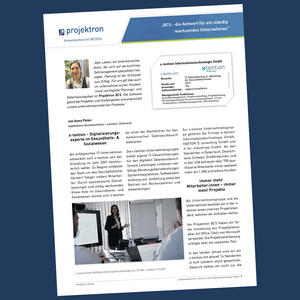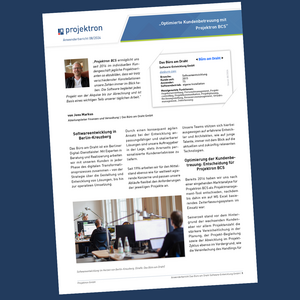03/03/2023 - Articles
Functional iterative software implementation: module by module to success
The functional iterative software implementation is a variant of the iterative, step-by-step implementation of modular enterprise software. Find out here for which companies and which use cases this rollout strategy is suitable, where its advantages and disadvantages lie, and how you can use the functional iterative method for your software rollout project in a targeted manner.
What is functional iterative software implementation?
To successfully implement complex enterprise software, it is important to choose the right strategy. In the functional iterative approach, the individual functional modules of the new software are introduced into the company one after the other. Of course, this assumes that the software is a modular product consisting of individual functional modules that are functional and ready for use on their own. The approach can therefore also be described as a module-by-module iterative implementation.
All users start using the new software module at the same time and across departments. The introduction of the next module takes place only after:
- the use of the module has been fully adapted and accepted,
- problems have been identified and solved
- all necessary interfaces have been implemented.

Definition of functional iterative software introduction
According to the functional iterative approach, a company introduces the various modules of a software successively. The entire user community is given access at once, but in a functionally staggered manner, for example, gradually module by module.
This approach buys the developers time to develop the interfaces of the modules one by one. If the company wants to replace various software products with one overall solution, the functional iterative implementation is a good choice.
What is important to consider in functional iterative software implementation?
In the preparatory phase of the software introduction project according to the functional iterative approach, it is essential for project managers to pay attention to the functional dependency of the modules on each other. From this dependence a meaningful introduction sequence is to be derived. According to this implementation sequence, in turn, the work breakdown structure must be designed accordingly.

Example from practice
When implementing the Projektron BCS business coordination software, the modules for time recording and vacation planning should be introduced before the resource management module, as resource planning or personnel resource planning is based on the recording of working hours and vacation planning.
Before the introduction of each individual module, employees should be trained in its use and it must be determined to what extent the legacy system is to remain connected. This must be taken into account in the project planning for the entire implementation project.
In the case of closely coupled functional modules that are highly interdependent, simultaneous implementation makes sense. Such a simultaneous introduction of two modules is advisable, for example, in the case of the function modules for quotation generation and project-specific document management, as this is the only way to send quotations with accompanying documentation. In the context of project management software, however, function modules such as time recording and project planning should not be introduced as the first modules at the same time, as this significantly increases the complexity of the introduction and can quickly lead to problems.
The selection of the module for the first iteration has a signal effect on user acceptance and should therefore be well considered and its introduction well prepared. Once the workforce has gained a positive view of the software introduction, this greatly simplifies the subsequent introduction phases. A functional module that can be easily used by all employees and whose benefits are quickly apparent to every user is a good choice here, for example a digital system for recording working hours and vacation management.
Functional iterative software implementation: advantages and disadvantages
 |  | |
|
| |
|
| |
|
| |
|
| |
|
When is functional iterative software implementation recommended?
The functional iterative strategy is recommended when processes are to be implemented in the same way throughout the entire company at all locations and departments. This makes this form of software introduction particularly attractive for corporations with a high level of employee participation. Functional iterative implementation is also recommended if the company previously used several software solutions for different areas of activity, which are now to be replaced by an overall solution and many individual adjustments are to be made and new interfaces programmed.
The functional iterative strategy shows its strengths when:
- Many locations are to introduce the new software
- Many process changes accompany the introduction
- Many new function modules are to be introduced
- New interfaces have to be developed and many adjustments have to be made
- A resilient schedule exists
- No more than three legacy systems are to be replaced by the new software
- At least moderate management support, motivation of the users and experience of the project manager are available
When is the functional iterative software implementation not useful?
If a company has several sites, a functionally iterative implementation can sometimes be very complex and time-consuming, especially if the different sites also use different software products that need to be replaced. This places high demands on the project management of the implementation project. If only a single function module is to be implemented, the functional iterative strategy is not applicable. A regionally iterative approach or a project-oriented rollout would be preferable here.
What are the alternatives to functionally iterative software implementation?
Your framework conditions are not optimal for the application of functional iterative software implementation? Numerous other options are open to you:
Software implementation after Big Bang
With the big bang strategy, all software modules are activated for all users on a specific date. The new software replaces the legacy system holistically, so that users do not have to maintain processes in the new and legacy systems in parallel. However, the risk is high.
Project-oriented rollout
The project-oriented software rollout is a variant of the iterative, i.e. step-by-step software introduction. A small project team initially uses the new software as a tiger team in a typical company project. After appropriate adjustments, the introduction takes place company-wide.
Departmental or regional iterative rollout
The regional iterative software rollout and the departmental iterative software rollout, which follows the same principle, are variants of the iterative, step-by-step rollout. A company introduces a software completely with all desired function modules successively at different locations or departments.
Combined implementation strategies
By combining big-bang and iterative process models, companies can develop tailored strategies for the introduction of enterprise software that are precisely tailored to their individual needs. This enables more precise and flexible implementation.
If you are unsure whether a functionally iterative software implementation is the appropriate approach for your implementation project, you can rely on our expertise. We have decades of experience in the introduction of complex enterprise software and can support your project team individually and competently through strategy development, training, workshops and consulting.
Best Practice: Functional iterative introduction of Projektron BCS at x-tention
Anna Pieler, Application Manager at x-tention Informationstechnologie GmbH in Wels, Austria, presents a best-practice example of an all-round successful functional iterative BCS implementation in the case study:
"The introduction of BCS took place as a separate project and was carried out simultaneously in the different locations.
The project was introduced in two phases: Phase 1 roll-out of Projektron BCS per se and establishment as the leading central tool in project management (replacement of MS Office tools for PM as well as replacement of the previous project time recording system) and establishment of the most important interfaces to other x-tention tools.
We took a one-year break between the phases to train the employees in Projektron BCS and to incorporate enhancements and customizations.
In phase 2, BCS was customized, the functions expanded and adapted to x-tention workflows and processes. The introduction of the new functions was accompanied by internal training and increased the integration of BCS with regard to evaluations of KPIs for our ISO 9001 and ISO 27001 certifications."
Best practice: Functional-iterative software implementation for optimized customer service at "Das Büro am Draht"
"Das Büro am Draht", a renowned Berlin-based digital agency for software development, opted for a functional-iterative approach when introducing Projektron BCS in order to optimally integrate the software into its existing processes. Initially, time recording was implemented as a basic function, supported by workshops and training sessions that enabled a smooth transition from the previous system. With the data obtained, further steps such as monitoring and project planning could be implemented in BCS immediately.
Through targeted enhancements and adjustments, Projektron BCS gradually developed into the company's central tool, which now covers both controlling and invoicing. This iterative approach made it possible to continuously adapt the software to the company's specific needs, while at the same time employees were gradually introduced to the new system, resulting in seamless integration and sustainable optimization of customer service.
Jens Markus, Head of Finance and Administration at the digital agency, describes the introduction and use of Projektron BCS at "Das Büro am Draht" in detail in the case study.
Conclusion: Functional iterative software introduction
The functional iterative approach is a rollout strategy for modular enterprise software in which the individual functional modules are introduced into a company one after the other. In the process, dependencies must be taken into account and the implementation sequence as well as the work breakdown structure must be adapted. Employees must be trained before the modules are introduced and it must be determined how the legacy system is to remain connected.
The strength of this variant is that the interfaces of the modules are developed one after the other and problems can be solved before the next module is introduced. This implementation strategy is recommended if a process is to be carried out in the same way throughout the entire company.

About the author
Francisco Josué Artaza has been working with Projektron GmbH for 15 years, currently as marketing manager and user consultant. He is certified in IPMA, PRINCE2, and as a Scrum Product Owner. He is an expert in software implementation strategies and has developed a tool that facilitates the selection of the appropriate strategy.
















